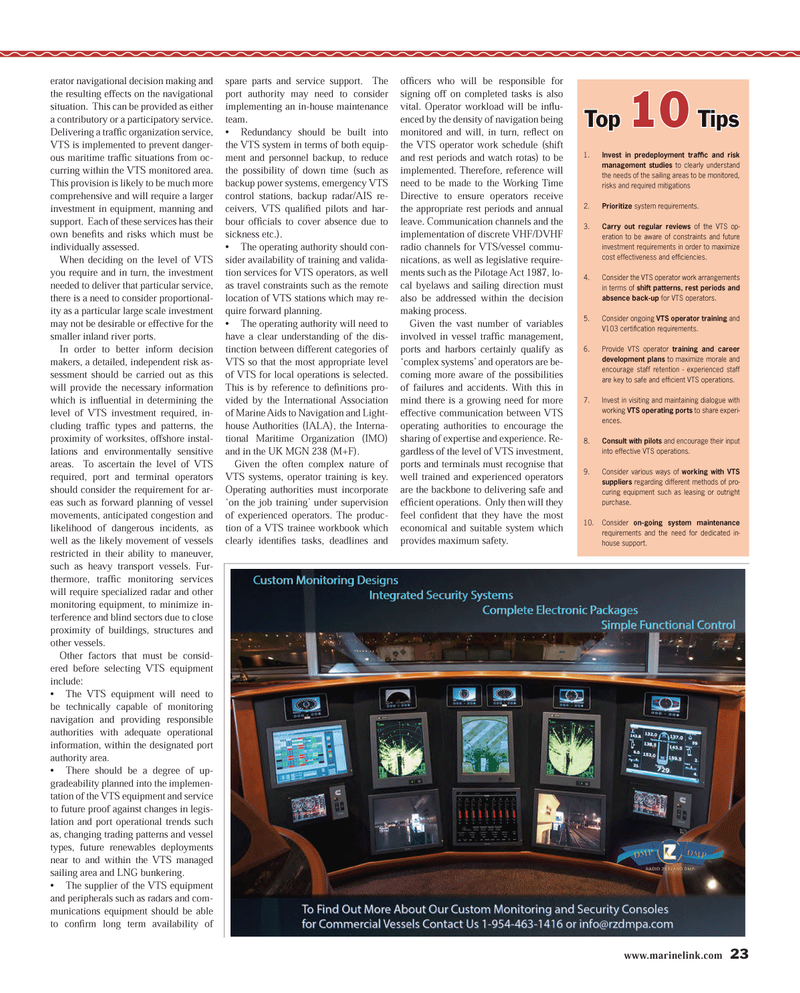
Page 23: of Maritime Reporter Magazine (December 2013)
Great Ships of 2013
Read this page in Pdf, Flash or Html5 edition of December 2013 Maritime Reporter Magazine
www.marinelink.com 23erator navigational decision making and the resulting effects on the navigational situation. This can be provided as either a contributory or a participatory service. Delivering a trafÞ c organization service, VTS is implemented to prevent danger- ous maritime trafÞ c situations from oc- curring within the VTS monitored area. This provision is likely to be much more comprehensive and will require a larger investment in equipment, manning and support. Each of these services has their own beneÞ ts and risks which must be individually assessed. When deciding on the level of VTS you require and in turn, the investment needed to deliver that particular service, there is a need to consider proportional-ity as a particular large scale investment may not be desirable or effective for the smaller inland river ports. In order to better inform decision makers, a detailed, independent risk as-sessment should be carried out as this will provide the necessary information which is inß uential in determining the level of VTS investment required, in- cluding trafÞ c types and patterns, the proximity of worksites, offshore instal- lations and environmentally sensitive areas. To ascertain the level of VTS required, port and terminal operators should consider the requirement for ar- eas such as forward planning of vessel movements, anticipated congestion and likelihood of dangerous incidents, as well as the likely movement of vessels restricted in their ability to maneuver, such as heavy transport vessels. Fur- thermore, trafÞ c monitoring services will require specialized radar and other monitoring equipment, to minimize in-terference and blind sectors due to close proximity of buildings, structures and other vessels.Other factors that must be consid-ered before selecting VTS equipment include:? The VTS equipment will need to be technically capable of monitoring navigation and providing responsible authorities with adequate operational information, within the designated port authority area.? There should be a degree of up- gradeability planned into the implemen-tation of the VTS equipment and service to future proof against changes in legis-lation and port operational trends such as, changing trading patterns and vessel types, future renewables deployments near to and within the VTS managed sailing area and LNG bunkering.? The supplier of the VTS equipment and peripherals such as radars and com-munications equipment should be able to conÞ rm long term availability of spare parts and service support. The port authority may need to consider implementing an in-house maintenance team.? Redundancy should be built into the VTS system in terms of both equip- ment and personnel backup, to reduce the possibility of down time (such as backup power systems, emergency VTS control stations, backup radar/AIS re-ceivers, VTS quali Þ ed pilots and har- bour ofÞ cials to cover absence due to sickness etc.).? The operating authority should con- sider availability of training and valida-tion services for VTS operators, as well as travel constraints such as the remote location of VTS stations which may re- quire forward planning.? The operating authority will need to have a clear understanding of the dis-tinction between different categories of VTS so that the most appropriate level of VTS for local operations is selected. This is by reference to deÞ nitions pro- vided by the International Association of Marine Aids to Navigation and Light- house Authorities (IALA), the Interna- tional Maritime Organization (IMO) and in the UK MGN 238 (M+F).Given the often complex nature of VTS systems, operator training is key. Operating authorities must incorporate ?on the job training? under supervision of experienced operators. The produc- tion of a VTS trainee workbook which clearly identiÞ es tasks, deadlines and ofÞ cers who will be responsible for signing off on completed tasks is also vital. Operator workload will be inß u-enced by the density of navigation being monitored and will, in turn, reß ect on the VTS operator work schedule (shift and rest periods and watch rotas) to be implemented. Therefore, reference will need to be made to the Working Time Directive to ensure operators receive the appropriate rest periods and annual leave. Communication channels and the implementation of discrete VHF/DVHF radio channels for VTS/vessel commu- nications, as well as legislative require-ments such as the Pilotage Act 1987, lo- cal byelaws and sailing direction must also be addressed within the decision making process.Given the vast number of variables involved in vessel trafÞ c management, ports and harbors certainly qualify as ?complex systems? and operators are be- coming more aware of the possibilities of failures and accidents. With this in mind there is a growing need for more effective communication between VTS operating authorities to encourage the sharing of expertise and experience. Re-gardless of the level of VTS investment, ports and terminals must recognise that well trained and experienced operators are the backbone to delivering safe and efÞ cient operations. Only then will they feel conÞ dent that they have the most economical and suitable system which provides maximum safety. Top Top 1010 Tips Tips 1. Invest in predeployment trafÞ c and risk management studies to clearly understand the needs of the sailing areas to be monitored, risks and required mitigations 2. Prioritize system requirements. 3. Carry out regular reviews of the VTS op-eration to be aware of constraints and future investment requirements in order to maximize cost effectiveness and efÞ ciencies. 4. Consider the VTS operator work arrangements in terms of shift patterns, rest periods and absence back-up for VTS operators.5. Consider ongoing VTS operator training and V103 certiÞ cation requirements. 6. Provide VTS operator training and career development plans to maximize morale and encourage staff retention - experienced staff are key to safe and efÞ cient VTS operations. 7. Invest in visiting and maintaining dialogue with working VTS operating ports to share experi- ences.8. Consult with pilots and encourage their input into effective VTS operations. 9. Consider various ways of working with VTS suppliers regarding different methods of pro- curing equipment such as leasing or outright purchase. 10. Consider on-going system maintenance requirements and the need for dedicated in- house support. MR #12 (18-25).indd 23MR #12 (18-25).indd 2312/11/2013 9:16:21 AM12/11/2013 9:16:21 AM

 22
22

 24
24
